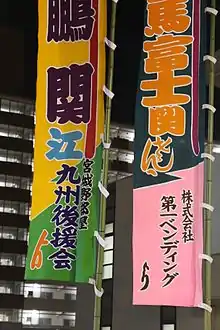| kana gojūon | ||||||||||||||||||||||||||||||||||||||||||||||||||||||||||||
|---|---|---|---|---|---|---|---|---|---|---|---|---|---|---|---|---|---|---|---|---|---|---|---|---|---|---|---|---|---|---|---|---|---|---|---|---|---|---|---|---|---|---|---|---|---|---|---|---|---|---|---|---|---|---|---|---|---|---|---|---|
|
||||||||||||||||||||||||||||||||||||||||||||||||||||||||||||
| Kana modifiers and marks | ||||||||||||||||||||||||||||||||||||||||||||||||||||||||||||
| Multi-syllabic kana | ||||||||||||||||||||||||||||||||||||||||||||||||||||||||||||
In the Japanese writing system kana ligatures (Japanese: 合略仮名, Hepburn: gōryaku-gana) are ligatures in the kana writing system, both hiragana and katakana. Kana such as koto (ヿ, from 事) and shite (𬼀, from 為) are not kana ligatures, but polysyllabic kana.
Hardly any kana ligatures or polysyllabic kana are represented in standard character encodings.
History

Nobori banners in sumo, using the yori ligature ゟ
These characters were widely used until a spelling reform of 1900 decreed that each sound (mora) would be represented by one (kana) character. They were not represented in computer character encodings until JIS X 0213:2000 (JIS2000) added yori and koto.
List
Hiragana ligature
| historical/Hepburn | image | character | Unicode | origin |
|---|---|---|---|---|
| かしこ/kashiko | - | - | 𛀚しこ | |
| こと/koto | - | - | こと[1][2] | |
| ごと/goto | - | - | ごと[1][2] | |
| さま/sama | - | - | さ𛃅[3][4] | |
| - | - | |||
| まいらせさうらふ/mairasesōrō | - | - | まいらせ候 | |
| - | - | |||
| より/yori | ゟ | U+309F | より[3][4][2] |
Polysyllabic hiragana
| historical/Hepburn | image | character | Unicode | origin |
|---|---|---|---|---|
| なり/nari | 𬼂 | U+2CF02 | 也[3][2][5][6] |
Katakana ligature
| historical/Hepburn | image | character | Unicode | origin |
|---|---|---|---|---|
| トイフ/toyū | - | - | ト云[3][7][8][9] | |
| トキ/toki | - | - | トキ[3][7][8][1][2][9] | |
| トテ/tote | - | - | トテ[3] | |
| トモ/tomo | 𪜈 | U+2A708 | トモ[3][7][8][1][2] | |
| ドモ/domo | - | - | ドモ | |
| ヨリ/yori | - | - | ヨリ[7][8][9] |
Polysyllabic katakana
| historical/Hepburn | image | character | Unicode | origin |
|---|---|---|---|---|
| イフ/yū | - | - | 云 | |
| コト/koto | ヿ | U+30FF | 事[3][7][8] | |
| シテ/shite | 𬼀 | U+2CF00 | 為[7][8] | |
| トキ/toki | - | - | 時[7][8][9] | |
| ナリ/nari | 𬻿 | U+2CEFF | 也[7][8][9] |
In Unicode
| Preview | ||||||||||||
|---|---|---|---|---|---|---|---|---|---|---|---|---|
| Unicode name | HIRAGANA DIGRAPH YORI | KATAKANA DIGRAPH KOTO | CJK UNIFIED IDEOGRAPH-2A708 | CJK UNIFIED IDEOGRAPH-2CEFF | CJK UNIFIED IDEOGRAPH-2CF00 | CJK UNIFIED IDEOGRAPH-2CF02 | ||||||
| Encodings | decimal | hex | dec | hex | dec | hex | dec | hex | dec | hex | dec | hex |
| Unicode | 12447 | U+309F | 12543 | U+30FF | 173832 | U+2A708 | 184063 | U+2CEFF | 184064 | U+2CF00 | 184066 | U+2CF02 |
| UTF-8 | 227 130 159 | E3 82 9F | 227 131 191 | E3 83 BF | 240 170 156 136 | F0 AA 9C 88 | 240 172 187 191 | F0 AC BB BF | 240 172 188 128 | F0 AC BC 80 | 240 172 188 130 | F0 AC BC 82 |
| UTF-16 | 12447 | 309F | 12543 | 30FF | 55401 57096 | D869 DF08 | 55411 57087 | D873 DEFF | 55411 57088 | D873 DF00 | 55411 57090 | D873 DF02 |
| Numeric character reference | ゟ | ゟ | ヿ | ヿ | 𪜈 | 𪜈 | 𬻿 | 𬻿 | 𬼀 | 𬼀 | 𬼂 | 𬼂 |
See also
Look up 合略仮名 in Wiktionary, the free dictionary.
References
- 1 2 3 4 普通日本文典 落合直文ほか 1893年
- 1 2 3 4 5 6 和漢の文典 : 雅俗対照
- 1 2 3 4 5 6 7 8 日本大文典. 第1編 P.42-45 落合直文 1894年
- 1 2 ことばの泉 : 日本大辞典 (21版) P.3 落合直文 1904年
- ↑ 児玉幸多『くずし字解読辞典〔普及版〕』東京堂出版 1993年 ほか
- ↑ 田島毓堂「法華経為字和訓考—資料編(三)—」名古屋大学文学部研究論集 1990年
- 1 2 3 4 5 6 7 8 國語學大系 第七巻 文字(一) P.302-303 福井久蔵 1939年
- 1 2 3 4 5 6 7 8 仮字本末 伴信友 1850年
- 1 2 3 4 5 操觚便覧藤井乙男編 1899年
This article is issued from Wikipedia. The text is licensed under Creative Commons - Attribution - Sharealike. Additional terms may apply for the media files.